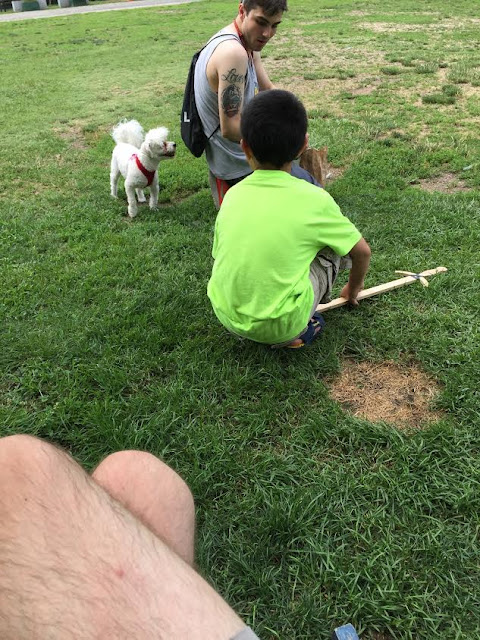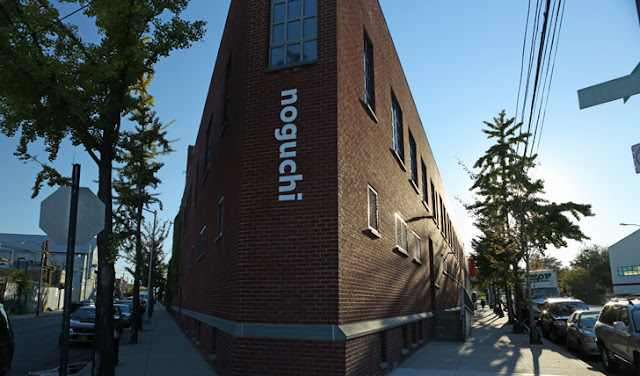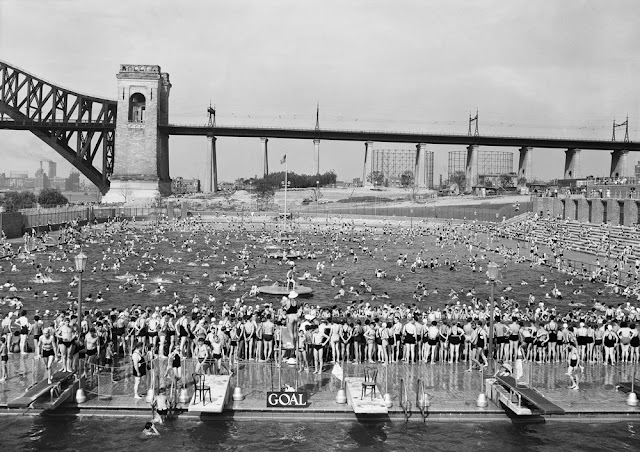Previously, I took you through some streets in Astoria. We ended at the intersection of Broadway and Vernon Boulevard at Socrates Sculpture Park.
Come with me to enter the energetic--yet peaceful--park.
You must try XXX Coffee (no, it's not X-rated), run by Drew DeGeer (a world-champion barista judge) and his helper, Elliot (below).
Socrates Park is the ONLY place that he purveys his amazing coffees, and he sets up "shop" on Saturdays, from Spring until Autumn. Yes, they accept credit cards.

Aside from free outdoor performances by the Met Opera (above), there are free outdoor movies,
free art classes (below),
...and Shakespeare in the Park--which unlike Manhattan's doesn't require waiting overnight on a long line for seats! Local eateries sell food during the events, too (not to mention the ice cream truck at the gate). We also enjoy picking herbs & cherry tomatoes from its Community Garden.
The Summer Solstice garden party involves music, local food vendors, frozen ices, games, and a boating "sunset paddle", as the sun sets over the river.
There's always something to admire: the interaction between kindly strangers, folks enjoying Nature, buds on the tree alée, or romping dogs.
Some of the rotating art installations are interactive, too!
Above, a water-pump musical organ existed, last autumn.
Below, Lewis admires the carpentry of a new creation, while one of the caretaker's cats admires birds.

Aside from people-watching, it's fun watching the seasonal art installations go up.

In addition to free kayaking for everyone...
...there are educational wildlife classes (with rowboats) are given to inner-city kids.
It's done on the sandy shore of Astoria's Hallets Cove Beach:
Occasionally, we observe guys "cruising" the railing to tempt other men for fun.
For Nature-lovers like us, the area is a great place to enjoy twilight and fireflies. (Or to go kissing at night).
Public dance performances draw on Astoria's local talent, and bring choreographers and students from Manhattan.
Volunteers help tend the gardens: flower beds, lawn seed, shrubs, veggie gardens, and tree plantings.
In the picture above, you'll notice the whimsical "letter blocks" randomly incorporated in the wall that encircles the park (also visible on the outside of the park, along the sidewalk).
Below, a newly-crafted gate does little to keep out frolicsome children who enjoy racing along the "behind the scenes" maintenance trails, playing "Hide & Seek" ...
or the mischievous adults who like the secluded privacy...
...especially behind the huge tree (below).
Lewis and I enjoy this small nook, nestled underneath the curving tree trunks and cool leaves--perfect for sipping iced coffee and reading...
... while admiring the butterflies (who come for the blooming butterfly bushes, seen below).
We've savored many great sunsets by its water, too.
The "painted ladies" seen above are on 14th Place, a narrow lane that retains the width that horse-drawn carriages needed in that era. With so many historic buildings on it, the road could not be enlarged.

Seen above (through ornate iron gates) is a 17-room plantation-style mansion on 1/3 acre of land (which is huge for current homes in Queens). Built in 1832, it was initially the Craig-Baylies House. Like many homes in the area, it had a tunnel to the East River for access to the Manhattan ferry of the 19th-century. A native Astorian supported that tale of tunnels. She recalled exploring/playing amongst the tunnel network, which now lead to dead-ends, due to the demolition of the grand homes. Also, new buildings--with deeper foundations--blockaded more of the tunnels. Seen below, its front lawn contains fantastic topiaries, fountains, and gardens.
Seen above and below is the 1840 Robert Blackwell House (the family was related to the Baylies). Built in the era of Pride & Prejudice, it is now a church facility.
Several areas retain their pre-city origins by lacking paved sidewalks. It seems pleasantly rural.
Looking at the mansion below, we can only imagine how it might've served the community if it hadn't been demolished.

Its parsonage was demolished for an apartment building, yet its wrought-iron gates remain.
Before the church was built, the building that became its parsonage was a private school for women. Circa 1825, it was funded by NYC landowner, John Jacob Astor (before he got enmeshed in greedily buying up Manhattan land). Not realizing that he became a tightfisted "Scrooge", the entire community of Hallets Cove changed its name to Astoria, hoping to flatter/honor Astor and get money from him. It didn't work.
One block away is a Reformed Dutch Church of Hallets Cove, built in 1888.
Like the church, several local businesses have long histories, too.
Streets in the historic district predate the city's grid pattern, so they offer cul-de-sacs, curves, and quaintness. Consequently, several roads crisscross at odd angles. Vernon Boulevard merges with Astoria Boulevard, which slants eastward through the area before becoming straight. Newtown Road is also diagonal and was originally a Native American trail. British settlers named it for New Town (the former name of Elmhurst, circa 1664). During the American Revolution, British loyalists (royalists) of New York enlisted with regiments of the British Army and were quartered there throughout the winter. The amalgamation included Queen's Rangers (honoring the king's wife, Queen Charlotte), Prince of Wales' American Regiment (made of volunteers from Connecticut), King's Royal Rifle Corps (which still exists in the UK today), and King's American Regiment (initially garrisoned on Staten Island). They lived in cantonments that were built into the hillsides.
Numerous paths allow you to stroll through the park.
Plenty of calisthenics, games and sports occur all over: along the running track, tennis courts, basketball courts, skateboarding court, and via the outdoor-gym facilities.
Public dance performances draw on Astoria's local talent, and bring choreographers and students from Manhattan.
Sometimes, the spectators are equally interesting as the performers (as seen above)!
Volunteers help tend the gardens: flower beds, lawn seed, shrubs, veggie gardens, and tree plantings.
In the picture above, you'll notice the whimsical "letter blocks" randomly incorporated in the wall that encircles the park (also visible on the outside of the park, along the sidewalk).
Below, a newly-crafted gate does little to keep out frolicsome children who enjoy racing along the "behind the scenes" maintenance trails, playing "Hide & Seek" ...
or the mischievous adults who like the secluded privacy...
...especially behind the huge tree (below).
Lewis and I enjoy this small nook, nestled underneath the curving tree trunks and cool leaves--perfect for sipping iced coffee and reading...
... while admiring the butterflies (who come for the blooming butterfly bushes, seen below).
We've savored many great sunsets by its water, too.
*To learn more about that park, please use this link:
Heading briefly south, along Vernon Boulevard, you'll encounter the Noguchi Art Museum. Despite its pricey admission fee, its courtyard garden is serene. I love the pretty bark on the birch trees and the varieties of pines. Their gift shop/cafe is nifty, and the Japanese art is engaging.
A bit further is Rainey Park (named after a local bridge engineer).
It's a place for golf swings, biking, basketball, running, sun-bathing, dog-walking, picnics, and for people to set up their hammocks. A modern playground--with sprinklers--is fun (even for Lewis and I). Benches allow a view of jet skis and boats on the river, and Roosevelt Island. *Please use this link to explore Roosevelt Island:
It's a place for golf swings, biking, basketball, running, sun-bathing, dog-walking, picnics, and for people to set up their hammocks. A modern playground--with sprinklers--is fun (even for Lewis and I). Benches allow a view of jet skis and boats on the river, and Roosevelt Island. *Please use this link to explore Roosevelt Island:
Retracing our steps, passing Socrates again, we'll encounter another farmer's market on 14th Street. So as not to compete with Socrates, its open on Wednesdays. They recently distributed flyers through the neighborhood. I was impressed to read that they accept credit cards and "meal assistance" plans! How forward-thinking.
Look at the size of those varieties of beets! (Lewis loves 'em)
Heading north will take you to Astoria Park. Seeing the Triborough Bridge will guide you to it.
I suggest taking 14th (originally called Woolsey Street) or 12th Street (Welling Street). Along with 27th Avenue, they showcase ornate 19th-century homes and a few remaining mansions from when the area was called Astoria Village. On old maps, Astoria was considered the "West Gold Coast" of Long Island. Incidentally, Welling Court is nearby and has a 3-level home from the 1770s Revolutionary War era, but its current nondescript vinyl siding makes it unworthy of a photo.
Seen below, the Chamberlain-Taylor de Wayt House was constructed in 1845.
Look at the size of those varieties of beets! (Lewis loves 'em)
Heading north will take you to Astoria Park. Seeing the Triborough Bridge will guide you to it.
Seen below, the Chamberlain-Taylor de Wayt House was constructed in 1845.
The "painted ladies" seen above are on 14th Place, a narrow lane that retains the width that horse-drawn carriages needed in that era. With so many historic buildings on it, the road could not be enlarged.

As per the trend of their era, many of the houses are perched atop hills for grandeur.
Seen above and below is the 1840 Robert Blackwell House (the family was related to the Baylies). Built in the era of Pride & Prejudice, it is now a church facility.
Several areas retain their pre-city origins by lacking paved sidewalks. It seems pleasantly rural.
Looking at the mansion below, we can only imagine how it might've served the community if it hadn't been demolished.
The homes were built there because this area used to have a ferry slip from Manhattan island. The first ferries began in the 1600s. This 1800s map shows them in the center-left.
Recently, that area was taken for new "luxury development",
and a proposed streetcar line (which was supposedly bribed into proposal via the NYC mayor, and isn't popular amongst residents, due to its stupid route and cost).
Unlike Europe, NYC and America greedily ripped up their electric streetcar routes, in favor of gas-guzzling automobiles. Otherwise, we could use convenient trams to traverse the neighborhood. Originally, Astoria was a "streetcar suburb". In days of yore, Queens' trollies looked like this...
The old streets will bring you past one of three Queens Public Libraries in Astoria. Built by Andrew Carnegie in 1904 (originally in Flemish Revival design), it's the most handsome.
Recently, that area was taken for new "luxury development",
and a proposed streetcar line (which was supposedly bribed into proposal via the NYC mayor, and isn't popular amongst residents, due to its stupid route and cost).
Unlike Europe, NYC and America greedily ripped up their electric streetcar routes, in favor of gas-guzzling automobiles. Otherwise, we could use convenient trams to traverse the neighborhood. Originally, Astoria was a "streetcar suburb". In days of yore, Queens' trollies looked like this...
In NYC's grand days of President FDR's "New Deal", it was expanded to its current appearance (which included a unique entrance for Children).
You'll notice how this part of Astoria remains hilly and wasn't flattened out by the city planners.
Across the street is charmingly-cozy Astor Bake Shop, a breezy place for wine, sandwiches, baked goods or iced chai teas! It also affords splendid people-watching along the intersection.

Burning off any calories, let's walk up the hill, past St. George Episcopal Church (originated in 1825 and built in 1904). Its stones were surplus from the construction of the Queensboro Bridge. It and its gargoyles occupy land donated by Robert Blackwell. Its pre-Civil War historic graveyard abuts the library.
Its parsonage was demolished for an apartment building, yet its wrought-iron gates remain.
One block away is a Reformed Dutch Church of Hallets Cove, built in 1888.
Like the church, several local businesses have long histories, too.
Streets in the historic district predate the city's grid pattern, so they offer cul-de-sacs, curves, and quaintness. Consequently, several roads crisscross at odd angles. Vernon Boulevard merges with Astoria Boulevard, which slants eastward through the area before becoming straight. Newtown Road is also diagonal and was originally a Native American trail. British settlers named it for New Town (the former name of Elmhurst, circa 1664). During the American Revolution, British loyalists (royalists) of New York enlisted with regiments of the British Army and were quartered there throughout the winter. The amalgamation included Queen's Rangers (honoring the king's wife, Queen Charlotte), Prince of Wales' American Regiment (made of volunteers from Connecticut), King's Royal Rifle Corps (which still exists in the UK today), and King's American Regiment (initially garrisoned on Staten Island). They lived in cantonments that were built into the hillsides.
*Staten Island is officially named Richmond County, in honor of England's Duke of Richmond, the son of King Charles II.
Just north of that, we arrive at Astoria Park. The park straddles the two bridges that go into Astoria.
Below, is an ariel view of the park and the bridges: the 1929 Triborough (a.k.a. Robert Kennedy) Bridge and the 1917 Hells Gate railroad bridge (the world's longest steel arch bridge until 1931). Yes, Queensboro and Triborough are officially spelled differently.
Before he "lost his way" amidst megalomania, NYC Parks Commissioner, Robert Moses, built wondrous Public Works (in the Art Deco style of the era). The Astoria Pool was used for the 1936 Olympic tryouts (winners competed in Nazi Germany).
Numerous paths allow you to stroll through the park.
Plenty of calisthenics, games and sports occur all over: along the running track, tennis courts, basketball courts, skateboarding court, and via the outdoor-gym facilities.
Occasionally, the park is a gay "cruising area" where bi-curious and closeted homosexuals try to lure guys for casual fun in the lavatory or under the Hells Gate Bridge.
Others pause their cars under the noisy Triboro Bridge in the parking lot, where they have privacy.
On summery days, food trucks, festivals, "concerts under the stars" and outdoor movies keep summertime revelers happy.
Well, it's been a fun stroll. Rest up... and look forward to our next jaunt, as I walk us along 30th Avenue.
http://halfwindsorfullthrottle.blogspot.com/2015/06/walking-tour-astorias-restaurant-row.html
http://halfwindsorfullthrottle.blogspot.com/2015/06/walking-tour-astorias-restaurant-row.html
























































































































































No comments:
Post a Comment
Don't be shy: leave your comments :)